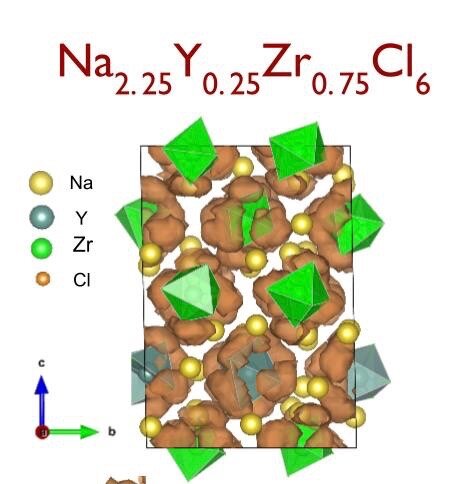A team of researchers designed and manufactured a new sodium-ion conductor for solid-state sodium-ion batteries that is stable when incorporated into higher-voltage oxide cathodes. This new solid electrolyte could dramatically improve the efficiency and lifespan of this class of batteries. A proof of concept battery built with the new material lasted over 1000 cycles while retaining 89.3% of its capacity—a performance unmatched by other solid-state sodium batteries to date.
Researchers detail their findings in the Feb. 23, 2021 issue of Nature Communications.
Solid state batteries hold the promise of safer, cheaper, and longer lasting batteries. Sodium-ion chemistries are particularly promising because sodium is low-cost and abundant, as opposed to the lithium required for lithium-ion batteries, which is mined at a high environmental cost. The goal is to build batteries that can be used in large-scale grid energy storage applications, especially to store power generated by renewable energy sources to mitigate peak demand.
“Industry wants batteries at cell-level to cost $30 to $50 per kWh,” about one-third to one-fifth of what it costs today, said Shirley Meng, a professor of nanoengineering at the University of California San Diego, and one of the paper’s corresponding authors. “We will not stop until we get there.”
The work is a collaboration between researchers at UC San Diego and UC Santa Barbara, Stony Brook University, the TCG Center for Research and Education in Science and Technology in Kolkata, India, and Shell International Exploration, Inc.
For the battery described in the Nature Communications study, researchers led by UC San Diego nanoengineering professor Shyue Ping Ong ran a series of computational simulations powered by a machine learning model to screen which chemistry would have the right combination of properties for a solid state battery with an oxide cathode. Once a material was selected as a good candidate, Meng’s research group experimentally fabricated, tested, and characterized it to determine its electrochemical properties.
By rapidly iterating between computations and experiments, the UC SanDiego team settled on a class of halide sodium conductors made up of sodium, yttrium, zirconium and chloride. The material, which they named NYZC, was both electrochemically stable and chemically compatible with the oxide cathodes used in higher voltage sodium-ion batteries. The team then reached out to researchers at UC Santa Barbara to study and understand the structural properties and behavior of this new material.
NYZC is based on Na3YCl6, a well-known material that is unfortunately a very poor sodium conductor. Ong suggested substituting zirconium for yttrium because it would create vacancies and increase the volume of the cell battery unit, two approaches that increase the conduction of sodium ions. Researchers also noted that, in conjunction with the increased volume, a combination of zirconium and chloride ions in this new material undergoes a rotating motion, resulting in more conduction pathways for the sodium ions. In addition to the increase in conductivity, the halide material is much more stable than materials currently used in solid-state sodium batteries.
“These findings highlight the immense potential of halide ion conductors for solid-state sodium-ion battery applications,” said Ong. “Further, it also highlights the transformative impact that large-scale materials data computations coupled with machine learning can have on the materials discovery process.”
Next steps include exploring other substitutions for these halide materials and increasing the battery’s overall power density, along with working to scale up the manufacturing process.
More information:
Erik A. Wu et al. A stable cathode-solid electrolyte composite for high-voltage, long-cycle-life solid-state sodium-ion batteries, Nature Communications (2021). DOI: 10.1038/s41467-021-21488-7
Provided by
University of California – San Diego
Citation:
New material is next step toward stable, high-voltage, long-life, solid-state batteries (2021, February 23)
retrieved 24 February 2021
from https://techxplore.com/news/2021-02-material-stable-high-voltage-long-life-solid-state.html
This document is subject to copyright. Apart from any fair dealing for the purpose of private study or research, no
part may be reproduced without the written permission. The content is provided for information purposes only.



